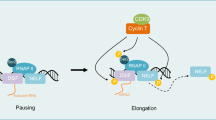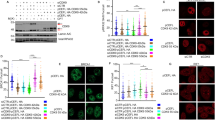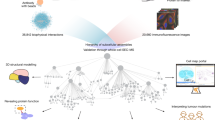Abstract
CD99 gene encodes two distinct proteins, produced by alternative splicing of CD99 gene transcript. Full-length CD99 isoform (CD99wt) is formed by an extracellular domain, followed by a transmembrane domain and a 36 amino-acid intracytoplasmic domain, which is partially deleted in the truncated, short form (CD99sh). A differential expression of these two CD99 molecules can lead to distinct functional outcomes in lymphocytes. To investigate the functional effects of CD99 molecules on malignancy, forced overexpression of the two CD99 isoforms was induced in osteosarcoma and prostate cancer cells. The two isoforms exhibited opposite functions: the major form dramatically inhibits anchorage-independent growth, anoikis resistance, migration and metastasis, whereas the CD99sh remarkably favours the phenomena. A mechanistic analysis of CD99-transfected osteosarcoma cells points to involvement of c-Src family kinase activity in regulating CD99 functions in malignancy. Ser168 residue of CD99 plays a pivotal role in the reversion of the malignant phenotype. Our findings highlight the involvement of CD99 in crucial processes of cancer malignancy, serving as a curtain raiser for this, so far neglected molecule. In addition, a dualistic role for the two CD99 isoforms was shown in agreement with what was observed for other cell adhesion molecules.
This is a preview of subscription content, access via your institution
Access options
Subscribe to this journal
Receive 50 print issues and online access
$259.00 per year
only $5.18 per issue
Buy this article
- Purchase on SpringerLink
- Instant access to full article PDF
Prices may be subject to local taxes which are calculated during checkout









Similar content being viewed by others
References
Alberti I, Bernard G, Rouquette-Jazdanian AK, Pelassy C, Pourtein M, Aussel C et al. (2002). CD99 isoforms expression dictates T cell functional outcomes. FASEB J 16: 1946–1948.
Ambros IM, Ambros PF, Strehl S, Kovar H, Gadner H, Salzer Kuntschik M . (1991). MIC2 is a specific marker for Ewing's sarcoma and peripheral primitive neuroectodermal tumors. Evidence for a common histogenesis of Ewing's sarcoma and peripheral primitive neuroectodermal tumors from MIC2 expression and specific chromosome aberration. Cancer 67: 1886–1893.
Ayrapetov MK, Wang YH, Lin X, Gu X, Parang K, Sun G . (2006). Conformational basis for SH2-Tyr(P)527 binding in Src inactivation. J Biol Chem 281: 23776–23784.
Benini S, Baldini N, Manara MC, Chano T, Serra M, Rizzi S et al. (1999). Redundancy of autocrine loops in human osteosarcoma cells. Int J Cancer 80: 581–588.
Bernard G, Breittmayer JP, de Matteis M, Trampont P, Hofman P, Senik A et al. (1997). Apoptosis of immature thymocytes mediated by E2/CD99. J Immunol 158: 2543–2550.
Bernard G, Raimondi V, Alberti I, Pourtein M, Widjenes J, Ticchion M et al. (2000). CD99 (E2) up-regulates alpha4beta1-dependent T cell adhesion to inflamed vascular endothelium under flow conditions. Eur J Immunol 30: 3061–3065.
Boyer B, Bourgeois Y, Poupon MF . (2002). Src kinase contributes to the metastatic spread of carcinoma cells. Oncogene 21: 2347–2356.
Byun HJ, Hong IK, Kim E, Jin YJ, Jeoung DI, Hahn JH et al. (2006). A splice variant of CD99 increases motility and MMP-9 expression of human breast cancer cells through the AKT-, ERK-, and JNK-dependent AP-1 activation signaling pathways. J Biol Chem 281: 34833–34847.
Cerisano V, Aalto Y, Perdichizzi S, Bernard G, Manara MC, Benini S et al. (2004). Molecular mechanisms of CD99-induced caspase independent-cell death and cell–cell adhesion in Ewing's sarcoma cells: actin and zyxin as key intracellular mediators. Oncogene 23: 5664–5674.
Dworzak MN, Froschl G, Printz D, Zen LD, Gaipa G, Ratei R et al. (2004). CD99 expression in T-lineage ALL: implications for flow cytometric detection of minimal residual disease. Leukemia 18: 703–708.
Fouchet C, Gane P . (2000). A study of coregulation and tissue specificity of XG and MIC2 gene expression in eukaryotic cells. Blood 95: 18919–18926.
Goto A, Niki T, Terado Y, Fukushima J, Fukayama M . (2004). Prevalence of CD99 protein expression in pancreatic endocrine tumours (PETs). Histopathology 45: 384–392.
Hahn JH, Kim MK, Choi EY, Kim SH, Sohn HW, Ham DI et al. (1997). CD99 (MIC2) regulates the LFA-1/ICAM-1-mediated adhesion of lymphocytes, and its gene encodes both positive and negative regulators of cellular adhesion. J Immunol 159: 2250–2258.
Huang WC, Xie Z, Konaka H, Sodek J, Zhau HE, Chung LW . (2005). Human osteocalcin and bone sialoprotein mediating osteomimicry of prostate cancer cells: role of cAMP-dependent protein kinase A signaling pathway. Cancer Res 65: 2303–2313.
Irby RB, Yeatman TJ . (2000). Role of Src expression and activation in human cancer. Oncogene 19: 5636–5642.
Jee B, Jin K, Hahn JH, Song HG, Lee H . (2003). Metastasis-suppressor KAI1/CD82 induces homotypic aggregation of human prostate cancer cells through Src-dependent pathway. Exp Mol Med 35: 30–37.
Jung KC, Park WS, Bae YM, Hahn JH, Hahn K, Lee H et al. (2002). Immunoreactivity of CD99 in stomach cancer. J Korean Med Sci 17: 483–489.
Kim SH, Shin YK, Lee IS, Bae YM, Sohn HW, Suh YH et al. (2000). Viral latent membrane protein 1 (LMP-1)-induced CD99 down-regulation in B cells leads to the generation of cells with Hodgkin's and Reed–Sternberg phenotype. Blood 95: 294–300.
Kreppel M, Aryee DN, Schaefer KL, Amann G, Kofler R, Poremba C et al. (2006). Suppression of KCMF1 by constitutive high CD99 expression is involved in the migratory ability of Ewing's sarcoma cells. Oncogene 25: 2795–2800.
Maitra A, Hansel DE, Argani P, Ashfaq R, Rahman A, Naji A et al. (2003). Global expression analysis of well-differentiated pancreatic endocrine neoplasms using oligonucleotide microarrays. Clin Cancer Res 9: 5988–5995.
Manara MC, Bernard G, Lollini P-L, Nanni P, Zuntini M, Landuzzi L et al. (2006). CD99 acts as an oncosuppressor in osteosarcoma. Mol Biol Cell 17: 1910–1921.
Marzia M, Sims NA, Voit S, Migliaccio S, Taranta A, Bernardini S et al. (2000). Decreased c-Src expression enhances osteoblast differentiation and bone formation. J Cell Biol 151: 311–320.
Porter M, Schindler T, Kuriyan J, Miller WT . (2000). Reciprocal regulation of Hck activity by phosphorylation of Tyr(527) and Tyr(416). Effect of introducing a high affinity intramolecular SH2 ligand. J Biol Chem 275: 2721–2726.
Recchia I, Rucci N, Festuccia C, Bologna M, MacKay AR, Migliaccio S et al. (2003). Pyrrolopyrimidine c-Src inhibitors reduce growth, adhesion, motility and invasion of prostate cancer cells in vitro. Eur J Cancer 39: 1927–1935.
Schenkel AR, Mamdouh Z, Chen X, Liebman RM, Muller WA . (2002). CD99 plays a major role in the migration of monocytes through endothelial junctions. Nat Immunol 3: 143–150.
Scotlandi K, Baldini N, Cerisano V, Manara MC, Benini S, Serra M et al. (2000). CD99 engagement: an effective therapeutic strategy for Ewing tumors. Cancer Res 60: 5134–5142.
Scotlandi K, Serra M, Manara MC, Benini S, Sarti M, Maurici D et al. (1996). Immunostaining of the p30/32MIC2 antigen and molecular detection of EWS rearrangements for the diagnosis of Ewing's sarcoma and peripheral neuroectodermal tumor. Hum Pathol 27: 408–416.
Scotlandi K, Serra M, Manara MC, Nanni P, Nicoletti G, Landuzzi L et al. (1993). Human osteosarcoma cells, tumorigenic in nude mice, express â1 integrins and low levels of alcaline phosphatase activity. Int J Oncol 3: 963–969.
Sohn HW, Choi EY, Kim SH, Lee IS, Chung DH, Sung UA et al. (1998). Engagement of CD99 induces apoptosis through a calcineurin-independent pathway in Ewing's sarcoma cells. Am J Pathol 53: 1937–1945.
Wijetunge S, Hughes AD . (1996). Activation of endogenous c-Src or a related tyrosine kinase by intracellular (pY)EEI peptide increases voltage-operated calcium channel currents in rabbit ear artery cells. FEBS Lett 399: 63–66.
Acknowledgements
We are in debt to Vanessa Cerisano, Silvia Liciulli and Stefania Perdichizzi for their excellent technical assistance. We thank Professor MF Di Renzo, Laboratory of Cancer Genetics, University of Turin at IRCC, 10060 Candiolo (Turin), Italy, and Professor M Grano, University of Bari, Italy, for kindly providing us normal human osteoblast cultures. This work was supported by AIRC (Associazione Italiana per la Ricerca sul Cancro) (K Scotlandi) and ARC (Association pour la Recherche sur le Cancer) (A Bernard) and the European Project PROTHETS.
Author information
Authors and Affiliations
Corresponding author
Additional information
Supplementary Information accompanies the paper on the Oncogene website (http://www.nature.com/onc).
Supplementary information
Rights and permissions
About this article
Cite this article
Scotlandi, K., Zuntini, M., Manara, M. et al. CD99 isoforms dictate opposite functions in tumour malignancy and metastases by activating or repressing c-Src kinase activity. Oncogene 26, 6604–6618 (2007). https://doi.org/10.1038/sj.onc.1210481
Received:
Revised:
Accepted:
Published:
Issue date:
DOI: https://doi.org/10.1038/sj.onc.1210481
Keywords
This article is cited by
-
CD99 as a novel therapeutic target on leukemic progenitor cells in FLT3-ITDmut AML
Leukemia (2022)
-
Anti-human CD99 antibody exerts potent antitumor effects in mantle cell lymphoma
Cancer Immunology, Immunotherapy (2021)
-
MMP-9 affects gene expression in chronic lymphocytic leukemia revealing CD99 as an MMP-9 target and a novel partner in malignant cell migration/arrest
Oncogene (2019)
-
CD99 at the crossroads of physiology and pathology
Journal of Cell Communication and Signaling (2018)
-
Integrated approaches to miRNAs target definition: time-series analysis in an osteosarcoma differentiative model
BMC Medical Genomics (2015)



